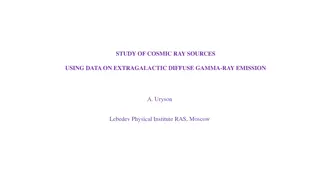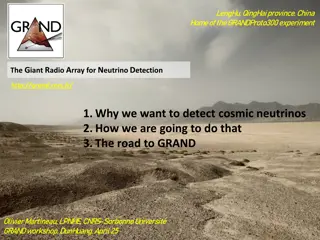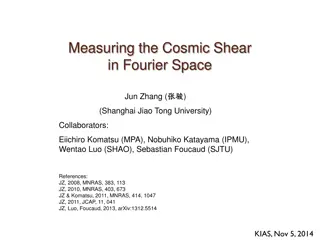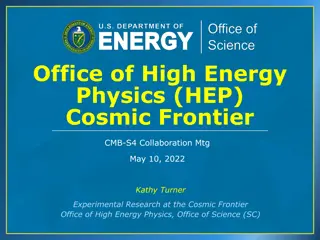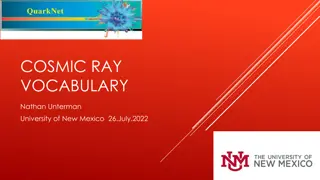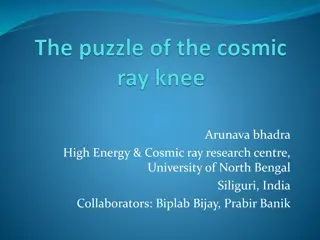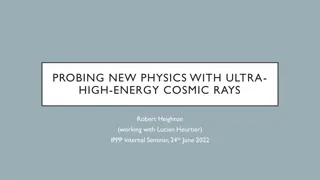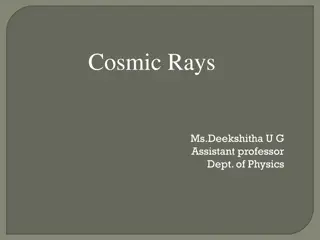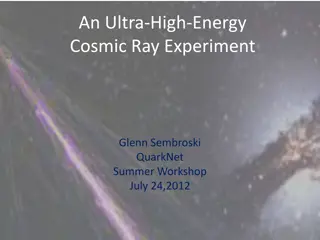Evolution of Cosmic Understanding: From Flat Earth to Heliocentrism
Over millennia, human perception of the universe has transformed from viewing the sky as a dome above a flat Earth to accepting the heliocentric model proposed by Copernicus. Ancient beliefs, such as the Hebrew view of the universe, gave way to Greek philosophers' spherical Earth theory and the eventual acceptance of heliocentrism despite initial opposition from the Catholic Church.
Download Presentation

Please find below an Image/Link to download the presentation.
The content on the website is provided AS IS for your information and personal use only. It may not be sold, licensed, or shared on other websites without obtaining consent from the author. Download presentation by click this link. If you encounter any issues during the download, it is possible that the publisher has removed the file from their server.
E N D
Presentation Transcript
Cosmology The study of the universe as a whole Written by David Ilsley
For thousands of years, people looked at the sky but had no real idea what it was. Being blue like the sea, some thought it must be made of water. Image: en.wikipedia.org
In the civilisations of the Middle East, theories developed as to the nature of the sky (the heavens) and the Earth. By about 500 BCE, the commonly held view was that the Earth was flat and round, that the sky was a transparent dome above the Earth (the firmament), that the Earth floated on water and that there was water above the firmament, making the sky blue.
This is reflected in the creation account in Genesis in the Bible. Image: en.wikipedia.org So God made the firmament and separated the water under the firmament from the water above it. And God said Let the water under the sky be gathered to one place and let dry ground appear.
Hebrew View of the Universe The sun, moon and stars were attached to the firmament. This was the universe they knew. They had no way of telling if there was anything else. Image: flickr.com
About 300 BCE, the Greeks worked out that the Earth was a sphere rather than being flat. Philosophers like Aristotle and Ptolemy proposed a model to explain the movements of the heavenly bodies. In his model the Earth was a sphere surrounded by spherical shells which rotated about the centre of the Earth carrying the starts, sun, moon and planets. Image: en.wikipedia.org
As well as going around the Earth, the planets also moved in smaller circles called epicycles to explain their retrograde motion. Image: commons.Wikimedia.org
In 1543 Copernicus suggested that the Earth and the other planets went around the Sun. This eliminated the need for the epicycles. Image: en.m.wikipedia.org This idea was unpopular with the Catholic Church because it contradicted many statements in the bible. But over the next couple of hundred years or so, the idea became generally accepted.
Giordano Bruno extended Copernicus ideas, suggesting that the stars were distant suns, possibly with their own solar systems with life on the planets. He also suggested that the universe was infinitely large and that it had no centre. These ideas all turned out to be true, but they weren t appreciated by the church at the time. Image: commons.Wikimedia.org Bruno was tried for heresy by the inquisition, found guilty and burned at the stake.
In the late 18th Century, William Herschel suggested again that the stars were the same sorts of things as the Sun. By 1900 it was well accepted that the Universe consisted of a collection of millions or billions of stars in the shape of a disk and that the Sun was just one of them. Image: en.wikipedia.org Other galaxies had been seen, but they were assumed to be nebulae within the Milky Way. The Milky Way was the universe. Beyond that was a void.
In the 1920s it was established (largely by Edwin Hubble) that the Milky Way was one of many galaxies (island universes) and that most other galaxies were moving away from us the universe was expanding. Image: jpl.nasa.org
This led to the idea of the big bang (and the alternative steady state theory). When the cosmic microwave background radiation was observed in the 1960s, the big bang theory became generally accepted. Image: commons.Wikimedia.org
From measurements of the distances of galaxies and the speed at which they are moving away, the age and size of the observable universe could be established. Image: en.wilipedia.org
The age of the universe is 13.8 billion years. The observable universe consists of all locations within the universe from which light has had time to reach Earth in those 13.8 Ga. It is a sphere centred on the Earth. Image: commons.Wikimedia.org
If the universe were not expanding, the radius of the observable universe would be 13.8 billion light years. But the universe is expanding, which makes the situation a little more complicated.
The regions at the edge of our observable universe were right beside us at the time of the big bang. But, for the first 380 000 years after the big bang, light could not travel freely through the universe it was opaque. There was plenty of light there it just bounced around continually between ions and electrons. It would have seemed like being in a fog. Image: en.wilipedia.org
At the end of that 380 000 years, the universe became cool enough (about 3000K) for the electrons to be captured by the atomic nuclei to make atoms. Image: pixabay.com This event is known as recombination.
After recombination, light could travel in straight lines all the way to us. We observe this light as the cosmic microwave background radiation (CMBR) coming from all directions in space. Image: commons.Wikimedia.org
At the time of recombination, the radius of the observable universe was about 100 million light years. So why did the light take 13.8 billion years to get here? It was because space was continually expanding ahead of the light photons, increasing the distance they had to travel. Image: pikist.com
So the light from the CMBR travelled for 13.8 billion years. But, as the photons travelled, the space behind them grew too. The locations from which the CMBR was emitted are now about 46 billion light years away from us. So the present radius of the observable universe is about 46 billion light years.
So after the 1920s it was known that the universe is expanding. It was also known from Einstein s general relativity that the gravity of the matter in the universe would tend to pull the universe back together and so slow the expansion. Image: needpix.com
If there was a high enough density of matter in the universe, then the expansion would eventually stop and the universe would then contract back to nothing a big crunch. If the density of matter was not high enough, then, although the expansion would slow down a bit, it would not slow down enough to ever stop it. The universe would expand for ever. There is a critical density between these cases, where the universe will stop expanding, but after an infinite time and when it is of infinite size.
The ratio of the density of the universe to this critical density is called , the Greek letter capital omega. (A small omega looks like .) If > 1, then the universe will collapse; If < 1, then it will expand for ever; If = 1, then it will stop at infinity. Image: ak.wikipedia.org
According to general relativity, the value of also determines the shape of space. Image: en.wikipedia.org
If > 1, space is said to have positive curvature or to be closed. It is a 3-dimensional analogue of the 2-dimensional surface of a sphere. Image: en.wikipedia.org If you could go far enough in one direction, you would come back to where you started, just like you would if you walked far enough in a straight line on the surface of the Earth. If the universe is closed, then it will be finite like the area of the surface of the Earth. Image: ak.wikipedia.org
Also, a very large triangle constructed in closed space will have the sum of its angles > 180 . Image: en.wikipedia.org And a very large circle constructed in open space will have a circumference less that times its diameter.
If < 1, space is said to have negative curvature or to be open. It is sometimes described as the 3-dimensional analogue of the 2-dimensional surface of a saddle, though this is much harder to visualise. Image: en.wikipedia.org However far you went in any direction, you would never come back to where you started. If the universe is open, then it will be infinite.
Also, a very large triangle constructed in open space will have the sum of its angles < 180 . Image: en.m.wikipedia.org And a very large circle constructed in open space has a circumference more that times its diameter.
If = 1, space is said not to be curved. It is said to be flat. Image: en.wikipedia.org However far you went in any direction, you would never come back to where you started. If the universe is flat, then it will be infinite.
Also a very large triangle constructed in flat space will have the sum of its angles = 180 . Image: commons.Wikimedia.org And a very large circle constructed in flat space has a circumference equal to times its diameter. This is the sort of geometry with which we are familiar on a small scale.
The shape of space can be inferred from the pattern of variation within the CMBR. It turns out that space is either exactly flat or is very close to it. Image: en.wikipedia.org
As the universe expands, its shape will always move away from flatness. If > 1, then it will increase over time. If < 1, then it will decrease over time.
For to be as close to 1 as it observed to be now, it would have had to have been within 10-60 of 1 just after the big bang. There are theoretical reasons why the big bang would be extremely unlikely to produce a universe which is so close to being flat. There are also reasons why the big bang would not have produced a universe as homogeneous as the one we see today.
To explain these unlikely features of the universe, Alan Guth, in the 1970s, came up with the theory of inflation. By this theory, between 10-35 s and 10-32 s after the big bang, the universe increased in diameter from 10-35 m to about the size of a grapefruit. Image: commons.Wikimedia.org
Image: wallpaperflare.com A grapefruit may not sound very big, but that is the same proportional increase as a tennis ball expending to fill the observable universe all within 10-32 seconds.
Before inflation, light could travel from one side of the universe to the other, so the whole observable universe was in contact and could become homogeneous.
Then, because inflation caused it to expand much faster than light, most areas became out of contact with most others. Inflation would produce a universe which was either exactly flat or extremely close to it. There was no longer any need to assign the flatness to luck.
Inflation and the flatness of the universe are now almost universally accepted. The cause of inflation is believed to be the energy released when the strong nuclear force separated from the electro-weak force. Image: commons.Wikimedia.org
So it seems the universe is flat and we can see why. The trouble is that when we look at the density of matter (in the form of stars and galaxies) in the universe, we get a value of of about 0.01. In other words there is only 1% of the matter required to make the universe flat. If that was all there was, the universe would have dispersed long ago.
By looking at the speed at which stars orbited spiral galaxies like the Andromeda Galaxy, it was discovered in the 1970s that stars were subject to far more gravity than could be provided by the observable matter in the galaxy. Calculations suggested that galaxies are embedded in spherical clouds of invisible matter. This invisible matter was termed Dark Matter (shown in blue in the picture). Image: flickr.com
It seemed that dark matter could make up 20-30% of the critical density the density required to make equal to 1. Image: pxhere.com
The nature of dark matter is still unknown. It is thought to consist of particles similar in mass to protons, but which interact with other matter only through gravity or when a dark matter particle collides directly with a baryon in the nucleus of an atom. This collision would make the baryon jiggle slightly. Image: needpix.com
Dark matter particles would be passing through space and all light matter all the time. It is estimated that there would be between 1 and 1000 collisions per day in 1 kg of ordinary matter, like cheese. Because atoms are always jiggling about anyway, scientists trying to detect dark matter have to keep the matter they are observing very close to absolute zero temperature. Image: commons.Wikimedia.org
We said that dark matter could make up 20-30% of the critical density required to make equal to 1. Could it make up the 99% required? It seems not for three reasons. Firstly, the observations of galaxies and galaxy clusters suggested that there wasn t enough dark matter there. Image: commons.Wikimedia.org
Secondly, if there had been that much dark matter, the proportion of hydrogen, helium and other elements produced in the big bang nucleosynthesis would have been quite different. Thirdly, if there had been that much dark matter, the pattern of galaxy formation after the big bang would have been quite different. Image: flickr.com
So, even with dark matter, some 70- 80% of the required critical mass was still missing. The universe was still very much under-weight. Image: pixabay.com
Then in the 1990s two groups of astronomers were observing the distance and red shifts of Type 1a supernovas in distant galaxies. Image: commons.Wikimedia.org This was to measure how much the expansion of the universe was slowing down. To their surprise, they found that the expansion was actually speeding up.
This can be explained in terms of the negative pressure that would result if empty space has energy. This energy is called dark energy . The amount of dark energy that would be required to produce the observed acceleration of expansion can be calculated and it comes to about 10-9 Joules/m3, which is about 70% of the critical mass required to make equal 1.
So here was the missing mass of the universe. And so everything ties together nicely and the observations can be explained in terms of a universe made up as shown below. Image: commons.Wikimedia.org
But what is dark energy? It s not really known, but the best suggestion is that it s energy that results from Heisenberg s uncertainty principle. Energy cannot be precisely defined over a short period of time. Therefore mass-energy can keep popping into existence as long as it pops out again within a very short time.



![❤[READ]❤ Cosmic Biology: How Life Could Evolve on Other Worlds (Springer Praxis](/thumb/21556/read-cosmic-biology-how-life-could-evolve-on-other-worlds-springer-praxis.jpg)







